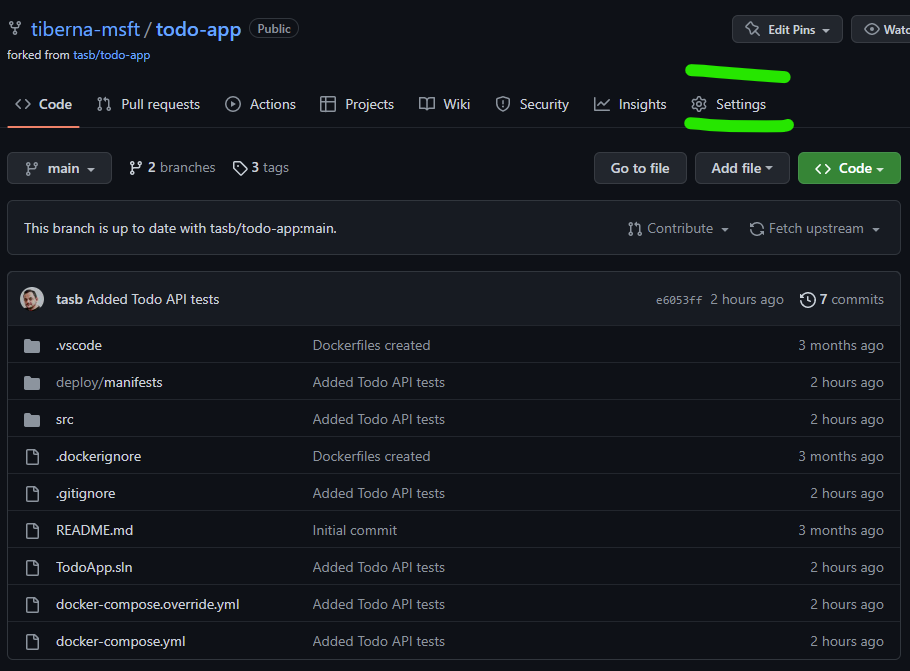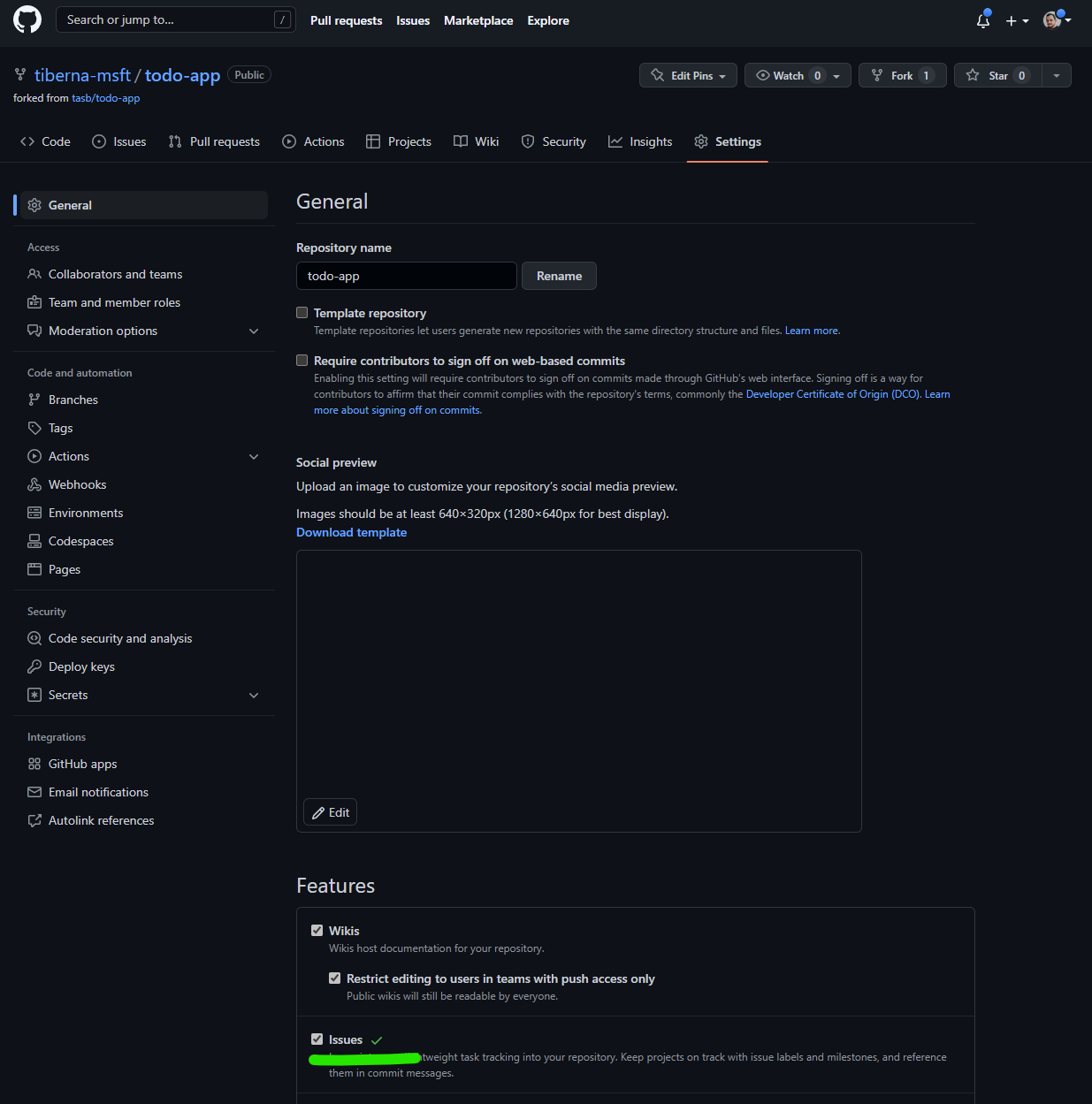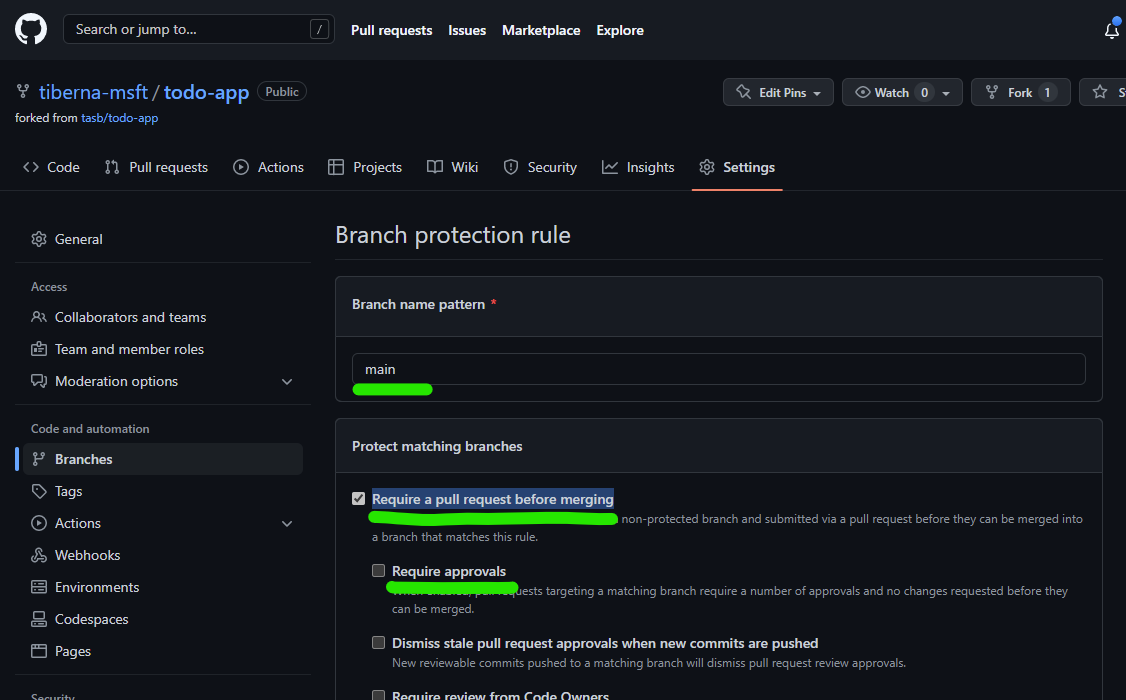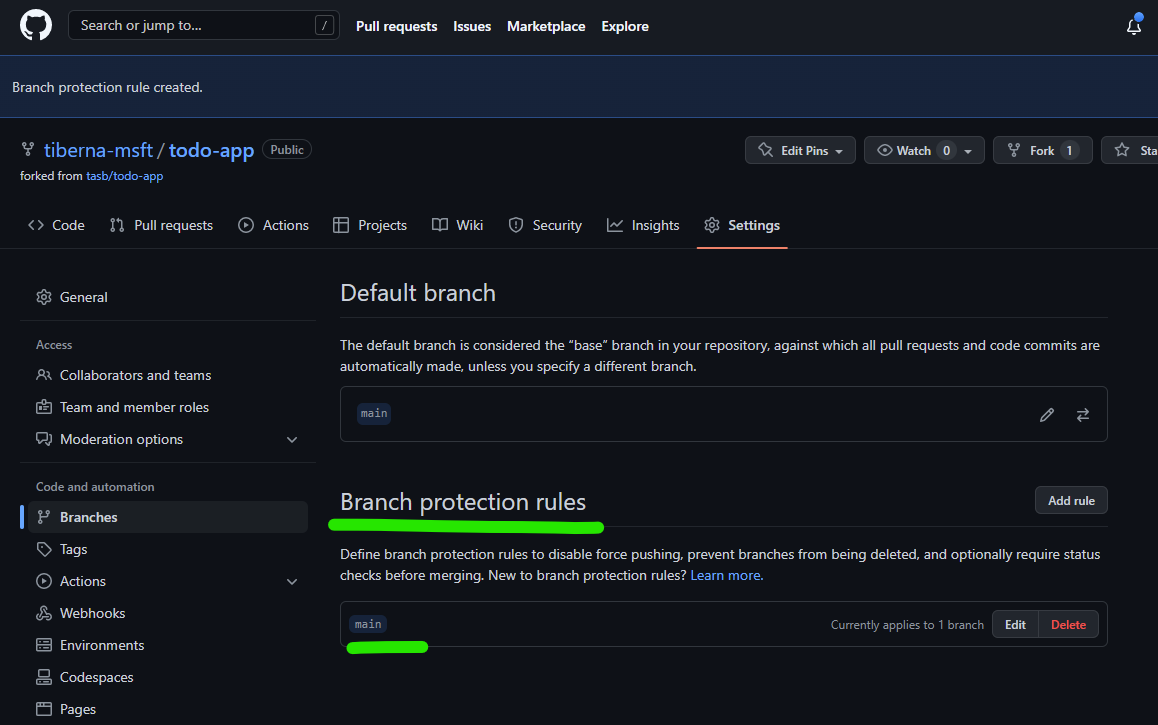secure-devops-training
Lab 05 - Create your initial workflow
Table of Contents
Goals
- Enable Pull Request workflows on your repository
- Configure Snyk to check for vulnerabilities on your project
- Configure SonarCloud to check for vulnerabilities on your project
- Check the results of the workflows
Guide
Step 01: Configure your repo
Before starting change your repo, let’s add some policies to enforce Pull Requests on main branch and enable Issues on your repo.
Click on Settings option on tool bar as shown on next image.

On main screen, check the Issues option to enable GitHub Issues on your repo.

Next navigate to Branches option available on the left side option, under block Code and Automation. On that screen click on Add classic branch protection rule button as shown on next image.

On new screen, add mainon Branch name pattern. This option will enable this policy on main branch, meaning that all merges (updates) on that branch must came from a Pull Request.
You need to enable the option Require a pull request before merging to enable the policy. You need to disable Required approvals option, since you’re the only user on that repo and by default, GitHub don’t allow that the creator of a pull request can approve his own changes.
At the end, your rule must have the following details.

After making this configuration, you need to click on Create green button on the bottom of this page. You may need to enter again your password to confirm this change. After you do that you must see a similar screen like the one below.

Now you’re repo is ready to receive the first workflow.
Step 02: Prepare SonarCloud
To integrate with SonarCloud using GitHub Actions, you need to create a new token on SonarCloud.
Navigate to the SonarCloud website and login with your GitHub account.
On the top right corner, click on your profile picture and then on My Account.
Then click on Security and then on Generate Tokens.
Add a name to the token and click on Generate.
Copy the token and save it on a safe place. You’ll need it on the next steps.
Now, navigate to your GitHub repository and click on Settings.
On left menu, click on option Secrets and variables and then on Actions.
Create a new repository secret named SONAR_TOKEN and paste the token you copied from SonarCloud.
Now you need two additional details from SonarCloud: the organization key and the project key.
Select the project your working and click on Information option on lower left corner.
You’ll get there the organization key and the project key that you’ll need to set on your workflow.
Last configuration is to disable the automatic scanning. Click on Administration and then on Analysis Method.
Disable the option Automatic Analysis.
Step 03: Prepare Snyk
To integrate with Snyk using GitHub Actions, you need to create a new token on Snyk.
Navigate to the Snyk website and login with your GitHub account.
On the bottom left corner, click on your profile name and then on Account settings.
On that page you can find your Auth Token.
Do the same process described before to add a new secret on your repository named SNYK_TOKEN.
Step 04: Pull Request Workflows
First, you need to create a new branch on your repo.
On your machine run the following command to create a new branch:
git checkout -b feature/add-pr-workflow
Now you create a new file named .github/workflows/todo-api-pr.yml with the following content:
name: TodoAPI PR
on:
pull_request:
branches: [ main ]
paths:
- 'src/TodoAPI/**'
- 'src/TodoAPI.Tests/**'
- '.github/workflows/todo-api-pr.yml'
jobs:
build:
runs-on: ubuntu-latest
permissions:
id-token: write
contents: read
checks: write
steps:
- uses: actions/checkout@v3
- name: Setup .NET
uses: actions/setup-dotnet@v2
with:
dotnet-version: 6.0.x
- name: Restore dependencies
run: |
dotnet restore src/TodoAPI/TodoAPI.csproj
dotnet restore src/TodoAPI.Tests/TodoAPI.Tests.csproj
- name: Build
run: |
dotnet build --no-restore src/TodoAPI/TodoAPI.csproj
dotnet build --no-restore src/TodoAPI.Tests/TodoAPI.Tests.csproj
- name: Test
run: dotnet test --no-build src/TodoAPI.Tests/TodoAPI.Tests.csproj --verbosity normal --logger "trx;LogFileName=test-results.trx"
- name: Test Report
uses: dorny/test-reporter@v1
if: always()
with:
name: Todo API Tests
path: '**/TestResults/*.trx'
reporter: dotnet-trx
sca:
runs-on: ubuntu-latest
needs: build
permissions:
contents: read
packages: read
actions: read
security-events: write
steps:
- uses: actions/checkout@v3
- name: Setup .NET
uses: actions/setup-dotnet@v2
with:
dotnet-version: 6.0.x
- name: Restore dependencies
run: |
dotnet restore src/TodoAPI/TodoAPI.csproj
dotnet restore src/TodoAPI.Tests/TodoAPI.Tests.csproj
- name: Run Snyk to check for vulnerabilities
uses: snyk/actions/dotnet@master
continue-on-error: true
env:
SNYK_TOKEN: $
with:
args: --sarif-file-output=snyk.sarif --file=TodoApp.sln
- name: Upload result to GitHub Code Scanning
uses: github/codeql-action/upload-sarif@v2
with:
sarif_file: snyk.sarif
- name: Publish security report to artifact
uses: actions/upload-artifact@v4
with:
name: snyk-report
path: snyk.sarif
security-analysis:
name: Security Analysis
runs-on: ubuntu-latest
needs: build
permissions:
contents: read
packages: read
actions: read
security-events: write
steps:
- name: Checkout Code
uses: actions/checkout@v4
# CodeQL Analysis
- name: Initialize CodeQL
uses: github/codeql-action/init@v3
with:
languages: 'csharp'
queries: 'security-extended,security-and-quality'
build-mode: 'none'
- name: Perform CodeQL Analysis
uses: github/codeql-action/analyze@v3
with:
category: "/language:csharp"
# SonarCloud Analysis
- name: Set up SonarCloud
uses: sonarsource/sonarcloud-github-action@v3.1.0
with:
projectBaseDir: src/TodoAPI
args: >
-Dsonar.organization=<your_sonar_org_key>
-Dsonar.projectKey=<your_sonar_project_key>
-Dsonar.verbose=true
env:
SONAR_TOKEN: $
GITHUB_TOKEN: $
Now let’s create a new workflow for the webapp. Create a new file named .github/workflows/todo-webapp-pr.yml with the following content:
name: TodoWebApp PR
on:
pull_request:
branches: [ main ]
paths:
- 'src/TodoWebapp/**'
- '.github/workflows/todo-webapp-pr.yml'
jobs:
build:
runs-on: ubuntu-latest
permissions:
id-token: write
contents: read
checks: write
steps:
- uses: actions/checkout@v3
- name: Setup .NET
uses: actions/setup-dotnet@v2
with:
dotnet-version: 6.0.x
- name: Restore dependencies
run: |
dotnet restore src/TodoWebapp/TodoWebapp.csproj
- name: Build
run: |
dotnet build --no-restore src/TodoWebapp/TodoWebapp.csproj
sca:
runs-on: ubuntu-latest
needs: build
permissions:
contents: read
packages: read
actions: read
security-events: write
steps:
- uses: actions/checkout@v3
- name: Setup .NET
uses: actions/setup-dotnet@v2
with:
dotnet-version: 6.0.x
- name: Restore dependencies
run: |
dotnet restore src/TodoWebapp/TodoWebapp.csproj
- name: Run Snyk to check for vulnerabilities
uses: snyk/actions/dotnet@master
continue-on-error: true # To make sure that SARIF upload gets called
env:
SNYK_TOKEN: $
with:
args: --sarif-file-output=snyk.sarif --file=TodoApp.sln
- name: Upload result to GitHub Code Scanning
uses: github/codeql-action/upload-sarif@v2
with:
sarif_file: snyk.sarif
- name: Publish security report to artifact
uses: actions/upload-artifact@v4
with:
name: snyk-report
path: snyk.sarif
security-analysis:
name: Security Analysis
runs-on: ubuntu-latest
needs: build
permissions:
contents: read
packages: read
actions: read
security-events: write
steps:
- name: Checkout Code
uses: actions/checkout@v4
# CodeQL Analysis
- name: Initialize CodeQL
uses: github/codeql-action/init@v3
with:
languages: 'csharp'
queries: 'security-extended,security-and-quality'
build-mode: 'none'
- name: Perform CodeQL Analysis
uses: github/codeql-action/analyze@v3
with:
category: "/language:csharp"
# SonarCloud Analysis
- name: Set up SonarCloud
uses: sonarsource/sonarcloud-github-action@v3.1.0
with:
projectBaseDir: src/TodoWebapp
args: >
-Dsonar.organization=<your_sonar_org_key>
-Dsonar.projectKey=<your_sonar_project_key>
-Dsonar.verbose=true
env:
SONAR_TOKEN: $
GITHUB_TOKEN: $
Please replace <your_sonar_org_key> and <your_sonar_project_key> with the values you got from SonarCloud.
Now you can push the changes to the remote repository:
git add -A
git commit -m "Add PR workflow"
git push
You can now create a Pull Request on your repo to test the workflow.
After all checks are done, you can merge the Pull Request.
Conclusion
You have now enabled Pull Request workflows on your repository and integrated Snyk and SonarCloud to check for vulnerabilities on your project.